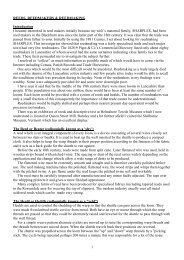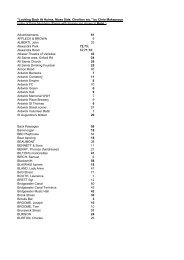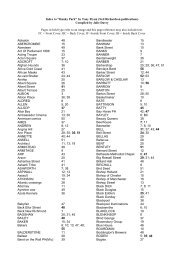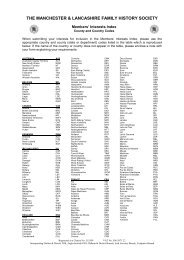The Roles of William and John Henry Royle in the Development of ...
The Roles of William and John Henry Royle in the Development of ...
The Roles of William and John Henry Royle in the Development of ...
You also want an ePaper? Increase the reach of your titles
YUMPU automatically turns print PDFs into web optimized ePapers that Google loves.
8<br />
<strong>the</strong> naked eye <strong>and</strong> many o<strong>the</strong>rs are already well advanced <strong>in</strong> this process. Add to this<br />
<strong>the</strong> natural processes <strong>of</strong> erosion, over <strong>the</strong> course <strong>of</strong> two centuries <strong>in</strong> some cases, which<br />
means that where c<strong>of</strong>f<strong>in</strong>s are stacked four deep <strong>in</strong> some graves an added weight can<br />
cause one to collapse <strong>in</strong> on ano<strong>the</strong>r. Hence, <strong>the</strong>re is fur<strong>the</strong>r rapid subsidence <strong>and</strong> we can<br />
see that <strong>the</strong>re are some areas <strong>of</strong> <strong>the</strong> churchyard which are <strong>in</strong> desperate need <strong>of</strong><br />
preservation. Accord<strong>in</strong>g to Lawson, <strong>the</strong> <strong>the</strong>n <strong>in</strong>cumbent, <strong>the</strong> Reverend Smith, had<br />
begun a process <strong>of</strong> catalogu<strong>in</strong>g <strong>the</strong> memorial <strong>in</strong>scriptions at Flixton churchyard, but it<br />
is not known how far advanced was this process, or whe<strong>the</strong>r it was ever completed.<br />
Hence, it is <strong>the</strong> aim with<strong>in</strong> <strong>the</strong> eight parts <strong>of</strong> this article, where possible, to record any<br />
relevant monumental <strong>in</strong>scriptions <strong>in</strong> order that <strong>the</strong>y may be <strong>of</strong> benefit to future<br />
researchers.<br />
Whilst on <strong>the</strong> subject <strong>of</strong> Flixton churchyard it would be useful to record <strong>the</strong><br />
observations <strong>of</strong> local historian Richard Lawson, who is particularly <strong>in</strong>formative on this<br />
matter. In 1898, at <strong>the</strong> time <strong>of</strong> writ<strong>in</strong>g his work, Lawson observes that, “On account <strong>of</strong><br />
its great age <strong>and</strong> former mode <strong>of</strong> irregular lay<strong>in</strong>g out <strong>of</strong> <strong>the</strong> ground, cannot be said to<br />
be pretty, but at any rate it is cared for.” (p.36) <strong>the</strong> north side <strong>of</strong> <strong>the</strong> church was used<br />
as part <strong>of</strong> <strong>the</strong> burial ground, unlike some Lancashire parishes, <strong>the</strong>re was no objection to<br />
this. <strong>The</strong> unknown dead were also buried on <strong>the</strong> north side only, with some smaller,<br />
blank stones del<strong>in</strong>eat<strong>in</strong>g <strong>the</strong>ir f<strong>in</strong>al place <strong>of</strong> rest. Today, <strong>the</strong> north side has had its<br />
headstones set to <strong>the</strong> ground, which probably occurred <strong>in</strong> <strong>the</strong> early 1960s, when <strong>the</strong><br />
centre <strong>of</strong> <strong>the</strong> village was demolished, <strong>in</strong> order to make way for <strong>the</strong> re - alignment <strong>of</strong><br />
Church Road <strong>and</strong> possible subsidence was an issue. It is <strong>in</strong> this general section that <strong>the</strong><br />
memorial <strong>in</strong>scriptions <strong>in</strong> ‘Part Two’ are drawn from, supported with <strong>in</strong>formation from<br />
<strong>the</strong> 1851 <strong>and</strong> 1841 censuses, where necessary.<br />
<strong>The</strong> 1851 Census (HO107 2218/397 No. 8) fur<strong>the</strong>r emphasises <strong>the</strong> dual<br />
entrepreneurial skills <strong>of</strong> a grocer <strong>and</strong> farmer discussed <strong>in</strong> ‘Part One’ <strong>and</strong> relat<strong>in</strong>g to <strong>the</strong><br />
1861 Census (RG09 2866/139 No. 34) In 1851 <strong>John</strong> <strong>Royle</strong> Senior is <strong>the</strong> head <strong>of</strong> <strong>the</strong><br />
household, aged 60 <strong>and</strong> a farmer, <strong>of</strong> Flixton although, <strong>the</strong> 1841 Census (HO107 543<br />
No. 27), lists him solely as a shopkeeper. With him is his wife Sarah Ann, aged 47 <strong>and</strong><br />
<strong>of</strong> Urmston; <strong>John</strong> Junior, <strong>the</strong>ir son, is unmarried, aged 27 <strong>and</strong> a baker, <strong>of</strong> Flixton:<br />
James, <strong>the</strong>ir son, is unmarried, aged 19 <strong>and</strong> a farmer, <strong>of</strong> Flixton; <strong>and</strong> Ellen Lewis, <strong>the</strong>ir<br />
servant, is unmarried, aged 22 <strong>and</strong> <strong>of</strong> Sheffield. <strong>The</strong> 1851 Census shows us that <strong>the</strong>re<br />
are <strong>the</strong> dual skills <strong>of</strong> farm<strong>in</strong>g <strong>and</strong> bakery be<strong>in</strong>g undertaken <strong>in</strong> <strong>the</strong> <strong>Royle</strong> household. By<br />
<strong>the</strong> 1861 Census <strong>the</strong>se skills had been comb<strong>in</strong>ed by <strong>John</strong> <strong>Royle</strong> Junior, on <strong>the</strong> death <strong>of</strong><br />
<strong>John</strong> <strong>Royle</strong> Senior, <strong>in</strong> 1856. <strong>The</strong> l<strong>and</strong> conveyance we see from 1876 to 1910 can be put<br />
<strong>in</strong>to <strong>the</strong> context <strong>of</strong> farml<strong>and</strong>, owned by <strong>the</strong> <strong>Royle</strong>s, be<strong>in</strong>g used for property<br />
development <strong>and</strong> rental returns. In 1851 <strong>the</strong>y are <strong>of</strong> Boat Lane, Flixton, which is <strong>the</strong><br />
short section <strong>of</strong> road at Towngate, to <strong>the</strong> west <strong>of</strong> Green Lane <strong>and</strong> end<strong>in</strong>g at <strong>the</strong> River<br />
Irwell, which could <strong>the</strong>n be crossed by a ferry, hence Boat Lane. <strong>The</strong>refore, it is likely<br />
that <strong>the</strong> <strong>Royle</strong>s became resident at Rocksavage sometime <strong>in</strong> <strong>the</strong> 1850s <strong>and</strong> certa<strong>in</strong>ly<br />
before <strong>the</strong> 1861 Census. <strong>The</strong> farms at Towngate were later occupied by members <strong>of</strong> <strong>the</strong><br />
Booth family, which can be dated with certa<strong>in</strong>ty to before <strong>the</strong> 1891 Census. However,<br />
monumental <strong>in</strong>scriptions at St. Michael’s churchyard show members <strong>of</strong> <strong>the</strong> Booth













